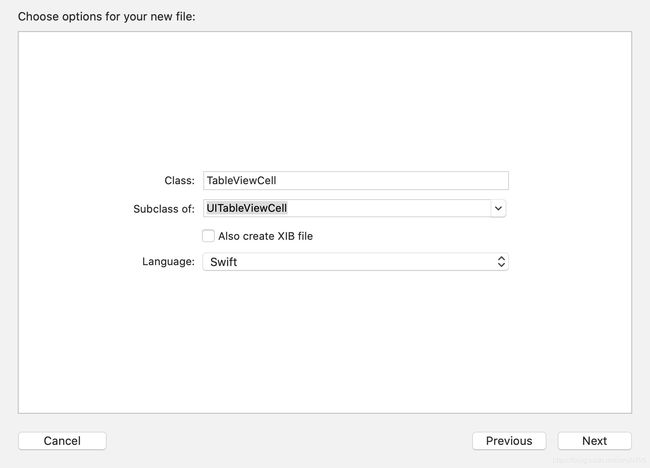swift tableView简单实用-01 自定义cell
系统提供的UITableViewCell很难满足我们的需求,自定义cell是常有的事,所以简单使用table后写了个自定义cell,具体如下:
1、创建自定义cell,继承UITableViewCell,开发语言选择swift,如下图所示:
2、定义之后,在引用的vc中,
1)在viewDidLoad中添加注册,
table.register(NormalCell.self, forCellReuseIdentifier: "normalcell")2)在代理方法cellForRowAt中,初始化cell,具体如下所示:
let cell = (tableView.dequeueReusableCell(withIdentifier: "normalcell", for: indexPath))as! NormalCell
cell.lbl.text = String(format: "行:%d", indexPath.row+1)//自定义cell中的元素
cell.logo.image = UIImage.init(named: "salary_select")//自定义cell中的元素3、在自定义cell中有两个元素,一个是UILabel,一个是UIImageView,其中定义有两种方式
方法一:
1)定义元素的时候,不设置默认值(即不初始化),代码如下:
var lbl:UILabel
var logo:UIImageView2)需要在复写的init初始化方法中,初始化元素,然后调用父类初始化方法,具体如下图:
方法二:
1)定义元素的时候,设置默认值(即初始化),代码如下:
var lbl = UILabel.init()
var logo = UIImageView.init()2)在复写的init初始化方法中,可以先调用父类初始化方法,再设置元素,这点和oc有点不一样,具体如下图:
4、运行结果如下图所示:
5、全部代码如下:
ViewController.swift
import UIKit
class ViewController: UIViewController, UITableViewDelegate, UITableViewDataSource {
func tableView(_ tableView: UITableView, numberOfRowsInSection section: Int) -> Int {
return 10
}
func numberOfSections(in tableView: UITableView) -> Int {
return 5
}
func tableView(_ tableView: UITableView, heightForHeaderInSection section: Int) -> CGFloat {
return 20
}
func tableView(_ tableView: UITableView, viewForHeaderInSection section: Int) -> UIView? {
let view = UIView.init()
view.frame = CGRect(x: 0, y: 0, width: UIScreen.main.bounds.size.width, height: 20)
view.backgroundColor = UIColor.lightGray
let lbl = UILabel.init()
lbl.frame = CGRect(x: 15, y: 0, width: 100, height: 20)
lbl.text = String(section)
view.addSubview(lbl)
return view
}
func tableView(_ tableView: UITableView, cellForRowAt indexPath: IndexPath) -> UITableViewCell {
// let cell = UITableViewCell.init(style: UITableViewCell.CellStyle.default, reuseIdentifier: "naormalCell")
// cell.textLabel?.text = String(format: "行:%d", indexPath.row+1)//String(indexPath.row)
// cell.selectionStyle = UITableViewCell.SelectionStyle.none
let cell = (tableView.dequeueReusableCell(withIdentifier: "normalcell", for: indexPath))as! NormalCell
cell.lbl.text = String(format: "行:%d", indexPath.row+1)
cell.logo.image = UIImage.init(named: "salary_select")
return cell
}
func tableView(_ tableView: UITableView, heightForRowAt indexPath: IndexPath) -> CGFloat {
return 60
}
func tableView(_ tableView: UITableView, didSelectRowAt indexPath: IndexPath) {
tableView.deselectRow(at: indexPath, animated: true)
let destination = SeconViewController()
destination.message = "传递的字符串"
self.present(destination, animated: true, completion: nil)
}
func tableView(_ tableView: UITableView, canEditRowAt indexPath: IndexPath) -> Bool {
return true
}
func tableView(_ tableView: UITableView, editingStyleForRowAt indexPath: IndexPath) -> UITableViewCell.EditingStyle {
return UITableViewCell.EditingStyle.delete
}
func tableView(_ tableView: UITableView, commit editingStyle: UITableViewCell.EditingStyle, forRowAt indexPath: IndexPath) {
if editingStyle == UITableViewCell.EditingStyle.delete {
//删除数据
}
}
func tableView(_ tableView: UITableView, titleForDeleteConfirmationButtonForRowAt indexPath: IndexPath) -> String? {
return "删除"
}
lazy var table:UITableView = {
let table = UITableView(frame: self.view.bounds,style: UITableView.Style.plain)
table.backgroundColor = UIColor.lightGray
return table
}()
override func viewDidLoad() {
super.viewDidLoad()
self.view .addSubview(table)
table.register(NormalCell.self, forCellReuseIdentifier: "normalcell")
table.delegate = self
table.dataSource = self
// Do any additional setup after loading the view.
}
}NormalCell.swift
import UIKit
class NormalCell: UITableViewCell {
var lbl = UILabel.init()
var logo = UIImageView.init()
override init(style: UITableViewCell.CellStyle, reuseIdentifier: String?) {
super.init(style: style, reuseIdentifier: reuseIdentifier)
lbl = UILabel.init(frame: CGRect.zero)
lbl.frame = CGRect(x: 65, y: 10, width: UIScreen.main.bounds.size.width, height: 40)
logo = UIImageView.init()
logo.frame = CGRect(x: 15, y: 10, width:40, height: 40)
logo.layer.cornerRadius = 5
logo.layer.masksToBounds = true
self.backgroundColor = UIColor.white
self.addSubview(lbl)
self.addSubview(logo)
}
required init?(coder aDecoder: NSCoder) {
fatalError("init(coder:) has not been implemented")
}
override func awakeFromNib() {
super.awakeFromNib()
// Initialization code
}
override func setSelected(_ selected: Bool, animated: Bool) {
super.setSelected(selected, animated: animated)
// Configure the view for the selected state
}
}
这样就可以实现自定义cell了



